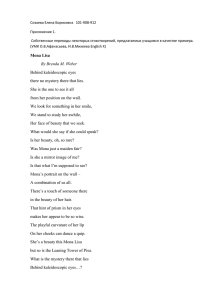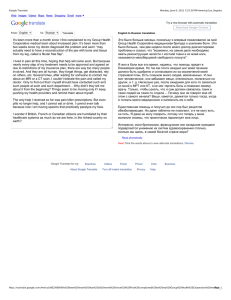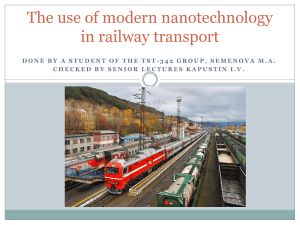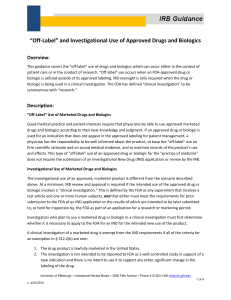Slide 1 - Who we are
реклама
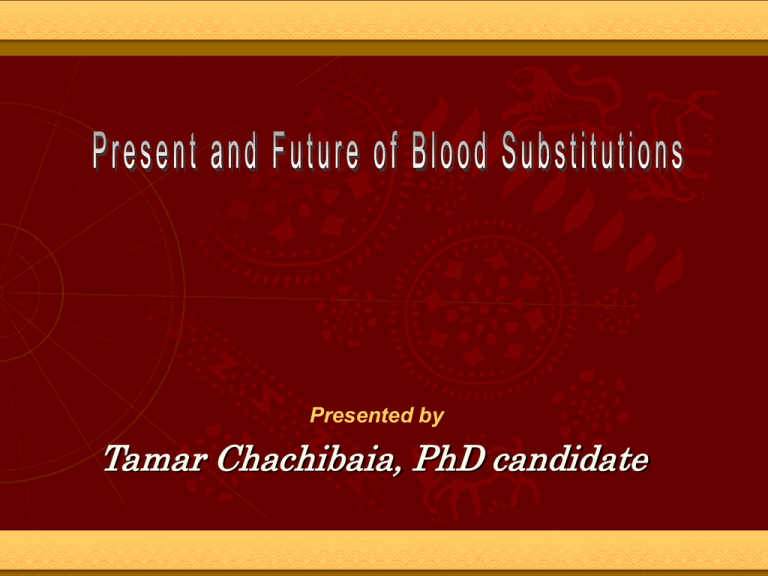
Presented by Tamar Chachibaia, PhD candidate • Conception of medical nanorobotics first was described by pioneer of nanomedicine, practitioner futurist, Robert A. Freitas Jr. • ”Respirocytes” is the short title of the original technical paper - “A Mechanical Artificial Red Cell: Exploratory Design in Medical Nanotechnology”, which was issued in 1996. CREDIT: URL: Nanomedicine Art Gallery http://www.fore sight.org/Nano medicine/Galler y/index.html Tiny diamondoid spheres, known as respirocites, representing hypothetical new class of medical device, filled with high pressure oxygen could release gases at a constant rate. Mechanical rotor maintains diffusion and exchange of oxygen, carbon dioxide, and water around the respirocyte – providing locomotion through the body. Blood substitutes are oxygen-carrying fluids • In his monograph R. Freitas highlights existing artificial respiratory gas carriers such as hemoglobin formulations and perfluorocarbon emulsions. These two concepts differ significantly from each other in several aspects. • 1st class of oxygen-carrying fluids are naturally occurring respiratory pigment, haemoglobin (Hb), second is synthetic, chemically inert, based on fluorinated liquids called perfluorochemicals (PFCs). Commercial products in both categories have been developed and some approved for clinical use, primarily to facilitate oxygen supply to tissues during surgery or therapy. HOW THE RESULTS OF THE PROJECT WILL CONTRIBUTE TO IMPROVED SECURITY? Not only atomic bomb explosions and nuclear powerplant accidents may raise awareness of lay people. Stunning criminal case committed against former Russian resident in London unleashed dreadful disadvantage of radiation danger for citizens as obvious threat to their security. In the time of asymmetric warfare, those countries and groups with less conventional power will look for unconventional methods. These include nuclear, biological, and chemical weapons. Only through research will we know the extent to which nanotechnologies may be used in these unconventional methods. Studies of nanotechnologies would be directed at defence rather than offensive tools to counteract measures of effect on people of radiological nuclear agents and weapons. Research is fostered by: 1. permanent shortages of donor blood supply, as well 2. risk awareness of HIV and Hepatitis viruses infections, 3. blood-type mix-up during transfusion. Precautionary alert is raised about dissemination of 4. specific protein, termed as prion, which is responsible for spongiform encephalopathy, capable to provoke disastrous outbreak of human variant Creutzfield-Jacobs disease. Along with physiological and economic aspects, public perception should be recognized about benefits and risks, associated with transfusion of blood, blood products or potential blood substitutes. Recent survey performed among young adults in UK finds that medical and law students differ over transfusion medical ethics. Particular clerical and cultural objection • In the special sections of medical manuals one can find numerous case studies with the descriptions of treatment guidelines, proposed to save critically ill patients in intensive care units without whole blood supply. Synthesized blood substitutes sought to match patient’s needs equally, while blood loss may cause inevitable threat of life. Suggestion by doctors to their patients alternative choice of nonblood treatment may facilitate to better cooperation between them, lower the emotional tension and avoid risk of religious stigma. Perhaps bloodless surgery is only an alternative therapy for Jehovah's Witnesses, thus bovine hemoglobin derived oxygen carriers is acceptable by Jehovah's Witnesses as yet. Nanotechnology perfluorocarbon emulsions (PFCE) • The risk of disease transmission, bacterial contamination or blood-type mix-up is entirely excluded by using a nonbiological or ‘abiotic’ oxygen carrier, that has been on-going for many years. First experiments with perfluorocarbon (PFC) compounds conducted in the 1960's paved the way for developing totally synthetic chemicals, that can dissolve and transport oxygen and other gases. While perfluorocarbon emulsions (PFCE) may never surpass the practice of blood transfusion, they have potential to reduce the need for transfused blood and to explore additional applications, such as conservation of organs for transplantation, in cardio-pulmonary bypass and other blood preserving manipulations. Nanotechnology perfluorocarbon emulsions (PFCE) Fluosol-DA (Green Cross Corp., Japan) & OXYGENT (Alliance Pharmaceutical Group) • Currently only some recognized perfluororganic carbon emulsion (PFCE) with gas transporting function are presented on the world market. In 1989 FDA first approved Fluosol-DA (Green Cross Corp., Japan) for use during angioplasty. It was withdrawn just five years later. Company began developing a second generation PFC called PHER-O2 in an effort to overcome the shortcomings of Fluosol. • Another prominent preparation OXYGENT developed by Alliance Pharmaceutical Group - Johnson & Johnson in 2007 is applied for FDA approval. anotechnology perfluorocarbon emulsions (PFCE) Perftoran Credit: G. R. Ivanitsky, 2008, July 09. • Another PFC-based oxygen carrier, Perftoran, was approved in 1996 for clinical use in Russia, which was originally developed at the Institute of Theoretical and Experimental Biophysics (Puschino, Russia), but relatively little information is available in the English literature for this product, hence it is not yet FDA approved. • More than thousands of patients participated in clinical studies of Perftoran. The indication statement for Perftoran claims that it is to be used in case of hemorrhagic and traumatic shock, blood losses, multiple trauma, burning of large surface of skin, conditions of apparent death, ischemic brain edema and acute ischemia, in regional perfusion to treat limb ischemia. Why Perftoran? Perftoran is considered to be the safest of the rest PFCEs. Average particle size in the Perftoran emulsion is in range of 65-70 nm. This is most optimal dimention of molecules in nanothechnology practice, as is determined by US National Nanotechnology Initiative guidelines. Particle size and surface characteristics are determining factors for decrease of reactivity of preparation. While altered erythrocytes fail to squeeze through contracted capillaries, or lumen, sludged by aggregated blood calls, 70 nm size molecules of Perftoran easily deliver gases to the oxygen deprived tissues, simultaneously carry carbon dioxide from tissues and transport it to the lungs for removal. Perftoran particles are removed from the bloodstream within 18-24 hours after administration. Understanding Size • 1 nanometer source: CERN http://microcosm.web.cern.ch/microcosm Capillary cross-section with red blood cells or erythrocytes inside. Capillaries are the small blood vessels that connect arteries and veins. Red blood cells carry oxygen throughout the body. SEM X5140 Credit: Photo by Kessel and Kardon, Visuals Unlimited Definitions of Nanotechnology adopted by FDA • FDA has not established its own formal definition .. FDA currently relies on the NNI definition. • National Nanotechnology Initiative (NNI): – Nanotechnology is the understanding and control of matter at dimensions of roughly 1 to 100 nanometers, where unique phenomena enable novel applications. …. At the nanoscale, the physical, chemical, and biological properties of materials differ in fundamental and valuable ways from the properties of individual atoms and molecules or bulk matter. • NCI Cancer Nanotechnology Plan (July 2004): – Nanotechnology refers to the interactions of cellular and molecular components and engineered materials - typically clusters of atoms, molecules, and molecular fragments - at the most elemental level of biology. Such nanoscale objects - typically, though not exclusively, with dimensions smaller than 100 nanometers - can be useful by themselves or as part of larger devices containing multiple nanoscale objects. The image to the right is a picture taken of a mouse completely submerged in liquid perfluorocarbon and still breathing! • In 1966: first report of mice immersed in a perfluorocarbon liquid saturated with oxygen; mice survived up to 10 minutes • На каждый эритроцит приходится свыше 105 частичек эмульсии Перфторана. Таким образом, эффективная поверхность 105 молекул Перфторана больше по сравнению с суммарной поверхностью одного эритроцита. Несмотря на то, что кислородная ёмкость ПФ приблизительно в 5 раз ниже цельной крови, благодаря оптимальному размеру частичек эмульсии Перфторана т.е. 70 нм, они способны проникать в стенозированный или закупоренный просвет капилляров, в местах недоступных для эритроцитов из-за их размера и деформации мембраны. Effects of Perftoran • Перфторан в большей степени оказывает не антианемическое действие, а точнее анти-ишемическое на тканевом и органном уровнях вследствии комплексного антигипоксического защитного механизма. То что до определенного момента является защитной функцией крови, впоследствии может служить повреждающим тригером (пусковым механизмом). В биологической крови присутствуют медиаторы воспаления, цитокины, активированные тромбогенетические факторы, фибрин и др. • Преимущество Перфторана заключается в том, что препарат лишен данных свойств биологической крови и является интактным для эндотелия. PFCE Perfluorocarbon emulsion • • Перфторан может стать средством спасения для той группы больных, которые находятся на лечении в палатах интенсивной терапии и шанс на улучшение общего тяжелого состояния не так велик. У пациентов, попавшим в палату интенсивной терапии с тяжелыми состояниями различного генеза в большинстве случаев, т.е. от 40 до 100% по данным разных клиник, развивается т.н. «Синдром эутиреоидного недуга». Отмечается критическое падение гормонов щитовидной железы, которое может наступить в течении 2-3 часов. • Смертность высокая и достигает 85%. Негативным прогностичским критерием является показатель Т4 ниже 2 ug/dl. При показателях Т4 ниже 4 ug/dl погибает половина больных . Alternative treatment options using Perftoran additionally to complex intensive insulin therapy in “Euthiroid Sick Syndrome” and possible role on improvement of morphfunctional status of the kidney . PFCE Perfluorocarbon emulsion • Действие тиреоидных гормонов в организме на поглощение кислорода, обмен газов, окислительные процессы хорошо изучены, как на целом организме, так на органном и тканевом уровнях. • Вопрос о применении заместительная терапии по сей день остается открытым. Использование тироксина однозначно не даёт никаких результатов. • Поиску новых средств, способных внести перелом в хрупком равновесии в борьбе за жизнь пациента уделяется немало усилий, времени и ресурсов. Препарат Перфторан может служить тем звеном, который внесет перелом в равновесии в борьбе за жизнь пациента, тем более что успешно применяется в интенсивной терапии в течении последних лет. Georgian National NanoInnovation Initiative is the Alliance Union inclusive of Initiative Group & NanoInnovation Center http://gnni.com.ge Founder Georgian National NanoInnovation Initiative & CEO of NanoInnovation Center: Ms. Tamar Chachibaia Tel/Fax: +(99532) 454556 E-mail: nanogeorgia@hotmail.com Thank you for your time


